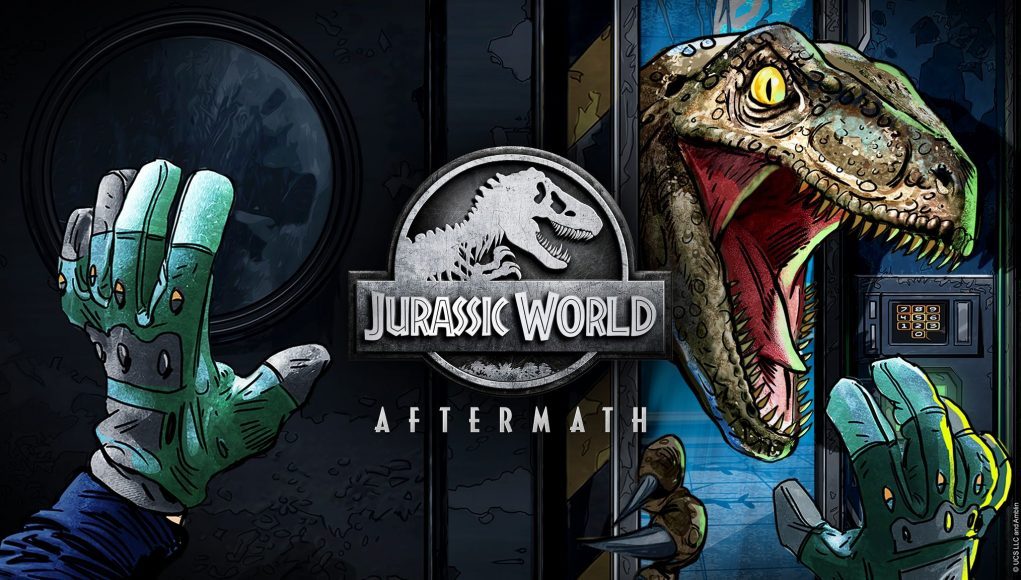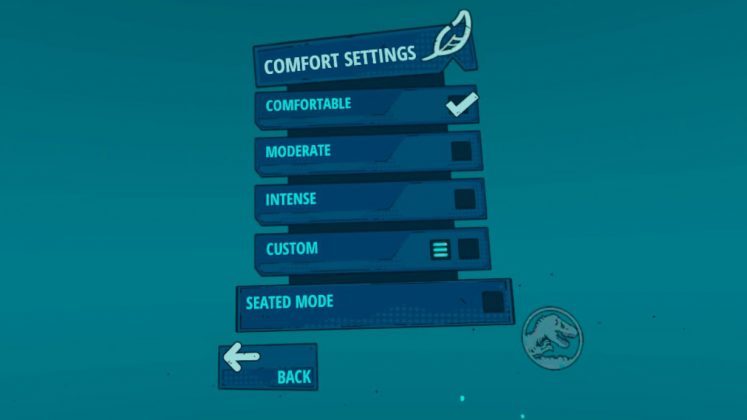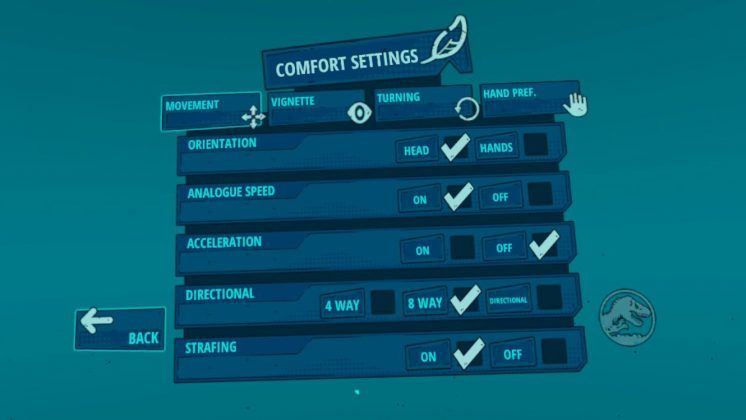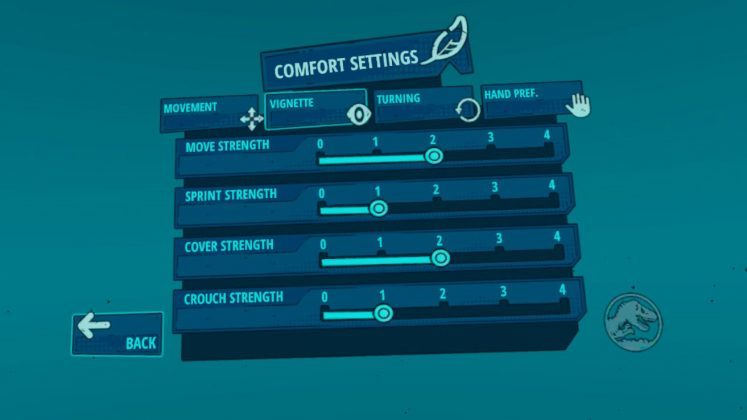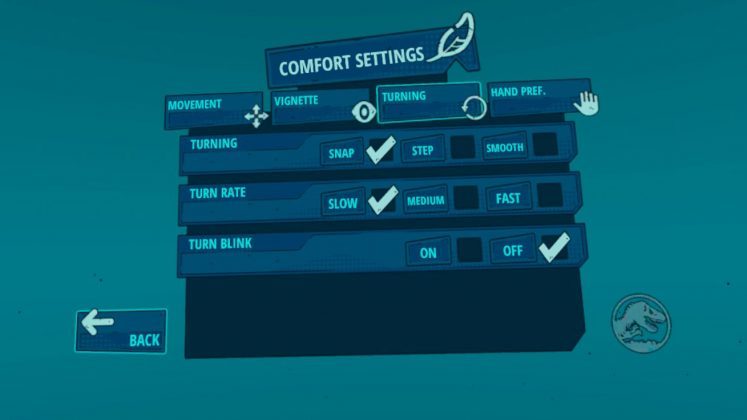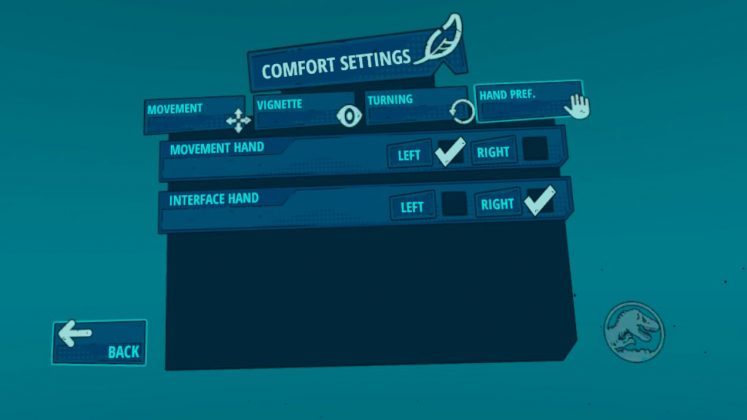Jurassic World Aftermath unabashedly hijacks the hide-and-seek gameplay of Alien Isolation (2014) while bringing it to VR with a Jurassic Park context and a unique and well executed visual style. With Part 2 now released as paid DLC, the game finally offers a complete narrative and gameplay arc.
Jurassic World Aftermath Details:
Available On: Oculus Quest
Release Date: Part 1 – December 17th, 2020, Part 2 – September 30th, 2021
Price: Part 1 – $25, Part 2 – $15
Publisher: Oculus Studios
Developer: Coatsink Software
Reviewed On: Quest 2
Update (October 5th, 2021): This review has been updated following the release of the Jurassic World Aftermath Part 2 DLC; each section below has additional impressions based on Part 2. The review score considers the experience of both Part 1 & Part 2 together; it has been changed from an overall 7.5 to 7.9.
Gameplay
VR is here and we can do literally anything with it. So, naturally, we’re going to pay people money to provide us with the feeling of being stalked by a deadly predator. If that’s what you’re into, Jurassic World Aftermath is the game for you.
Throughout the game you’ll be navigating a research facility to complete a series of objectives driven by a narrative that—while very well voiced—is delivered entirely via the old ‘voice on the radio’ trope.
Of course, finding your way around the facility and completing objectives is made slightly more complicated by the velociraptors that are loose. For the most part, the game plays out like a round of hide-and-seek, and if you’re found the penalty is death. You’ll need to be careful (and patient) to navigate without getting caught and sent straight back to your last checkpoint.
Along the way you’ll find cubbies, desks, and lockers which you can duck into to avoid being seen. There’s also some objects scattered around the environment—like radios, TV screens, and loudspeakers—which you can remotely activate to distract the raptors and make brief openings to slip by. Unfortunately all of the remotely activated objects function identically from a mechanical standpoint; more variety in how the player can interact with the raptors would have made things more interesting. Simply being able to throw objects as distractions seems like a missed opportunity given VR’s unique affordances.
The goal of a game like Jurassic World Aftermath is to create suspense (narrowly avoiding being caught) rather than frustration (being caught unpredictably, or in seemingly ‘unfair’ ways). Though it took me a bit of trial and error (read: being eaten several times in a row) to understand what I could and couldn’t get away with, ultimately the game creates a solid sense of suspense without too much frustration thanks to reasonably good raptor AI and mood-setting music & audible queues which help the player understand the threat level without being too obvious.
While that underlying sense of suspense is well delivered, the game would benefit from more variety in raptor encounters to keep things fresh. There’s a nice segment in the middle which mixes the pace up by changing the threat and giving more recourse than instantly dying if caught, but once it’s over it’s right back to pretty much the same hide-and-seek gameplay as before.
Even without introducing new enemies, there’s clear opportunity to ratchet up the capabilities of the raptors as the game progresses to make them seem like they’re learning and adapting to the player’s strategies. Not to mention introducing more novel scenarios. Some scenarios off the top of my head—the need to carry an object that would make noise at regular intervals (requiring planning from the player) or carrying a smelly object that would leave a scent trail for the raptors to follow (requiring the player to stay constantly on the move).
Hopefully the upcoming paid DLC ‘expansion’ will explore further along these lines. And while I certainly look forward to playing more of the game, this first portion ends on a cliffhanger that seems driven by a limited production schedule rather than a narrative choice.
I wouldn’t be bothered much by the game’s short three hour length if it was structured to feel whole, but as it stands it ends at what feel’s like the game’s half-way point without reaching a full narrative or gameplay arc—complete with an ‘Expansion coming soon!’ ad right after fading to black. It feels a bit like selling someone the first half of a book without telling them the second half isn’t included. Simply appending ‘Episode 1’ to the game’s title would have gone a long way to setting an appropriate expectation.
A note for anyone wondering how scary the game is: I’d probably call Jurassic World Aftermath a ‘suspense’ game more than a ‘horror’ game. There are zero jump scares, and actually being caught by a raptor isn’t really scary save for a brief moment when you stare down your inevitable demise. Horror buffs might not get the thrills they crave, but the game offers a nice dose of suspense that should be pretty approachable to anyone other than genuine scaredy-cats. (Update: although Part 2 still keeps the game firmly planted in the suspense genre, it does turn the scare factor up a notch or two, which I personally enjoyed.)
Update (October 5th, 2021): Part 2 picks up immediately where Part 1 left off. And it’s worth saying right up front: while Part 1 ended on a blatant cliffhanger, Part 2 brings the game to a proper conclusion.
At first Part 2 feels like more of the same, but as it goes on it introduces new mechanics and scenarios that mix up the gameplay beyond the basic raptor stalking. Being hunted by raptors while running around the facility completing small tasks is still pretty core to Part 2, but they’ve added some minor tweaks to keep you on your toes.
For instance there’s the addition of Compsognathus, the tiny and sometimes mischievous dinos featured in some of the films. In Part 2 you’ll find them strolling about the facility and if you get too close they’ll let out a high-pitched screech which will immediately call the attention of the raptors. You’ll have to steer clear otherwise you’ll be running for cover under the next table you see. Another tweak to the stealth raptor gameplay is some segments with broken glass on the floor which you must avoid otherwise the raptor will hear you. It adds additional tension to the sneaking gameplay where you need to be smart about where you can and can’t step.
Part 2 also brings some new scenarios with other dinosaurs, most of which are well executed. These were a welcome addition to the game, though I wish they were paced more evenly throughout the game. I’d say more about them, but I think it’s more fun to experience them for yourself. There was one particularly fun moment that I’ll avoid sharing here (so as not to spoil), but I’ll share it down in the comments below the article if you’re curious.
Part 2 took me about 3 hours and 20 minutes to complete (making Part 1 & 2 together about 6 hours and 20 minutes), and was every bit as polished as Part 1. While I can’t say the ending left too much impact on me—especially as we only ever gear to hear but never see any other characters—the story was at least well narrated and clearly concluded.
Immersion
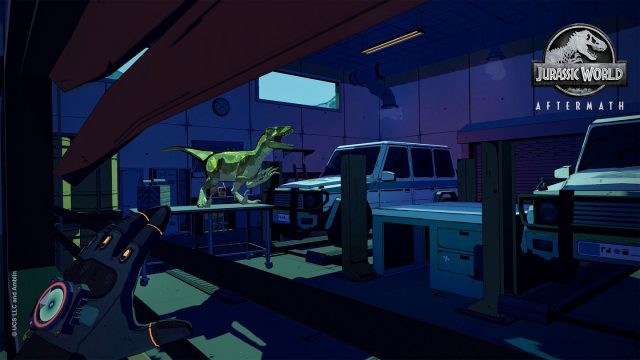 Immersion in Jurassic World Aftermath definitely starts with its unique visual style. While the comic-book look might not seem preferable to ‘realistic’ visuals, the reality is that Quest 2 doesn’t have enough graphical horsepower to aim for realistic graphics without looking like a game you’d find on a mid-2000’s console.
Immersion in Jurassic World Aftermath definitely starts with its unique visual style. While the comic-book look might not seem preferable to ‘realistic’ visuals, the reality is that Quest 2 doesn’t have enough graphical horsepower to aim for realistic graphics without looking like a game you’d find on a mid-2000’s console.
Stylistic graphics, then, are usually a good idea—though it’s difficult to pull off without careful art direction. In this case, Jurassic World Aftermath really nailed the look it was going for. Not only does it achieve a consistent style throughout, the game’s bold outlines and simple geometry actually look great because they save enough resources for high resolution and anti-aliasing, making every scene look well defined. That’s no simple feat considering the game mostly consists of dilapidated interior environments.
Beyond the look, sound design has seen a similar amount of care across the board, including the voice actors who you’ll hear over the radio. It’s a bummer that you never actually see the characters you hear throughout the game as it’s difficult to get attached to them through audio alone even if the dialogue is reasonably well written.
Sound is also crucial to the moment-to-moment gameplay. You’ll be carefully listening for spatialized raptor footsteps to assess whether you’re free to sneak about or if you’re about to get pounced on.
For the most part, the objectives you’re tasked with will require accessing computer terminals which are locked with a small handful of mini-games of the ‘Simon Says’ variety, but they’re done in an immersive way which makes them more engaging than tedious. Be prepared to feel the hairs on the back of your neck stand up as you try to quickly unlock a door while the sound of raptor footsteps approaches from behind (remember, you paid for this).
While there’s almost zero environmental interaction beyond specific, functional objectives like switches and computer terminals, the game was always clear about what I could and couldn’t touch, which is way better than the scattershot approach seen in some VR games where it’s hit or miss when you try to interact with something.
The raptors themselves look menacing and navigate fairly fluidly throughout the environment; it’s always fun to see their long tails round a corner or slide past you as you cower under a desk hoping to glimpse them without being seen.
The raptor animations can be a little stilted at times (much of this is forgiven thanks to the comic visual style), though some tweaks to certain behaviors would make them seem more intelligent.
Sometimes, for instance, if the raptor was close and I jumped into a locker or cubby to hide, it would walk right up to the opening and basically stare directly at me—as if it obviously knew I was in there—and then it would walk away. Seeing it walk slowly but suspiciously past my hiding spot would have better sold the illusion that I narrowly avoided being caught.
Update (October 5th, 2021): Part 2 doesn’t deviate much on immersion from Part 1. Though it does add a few new interactive mini-games which serve to keep things fresh.
It’s still a bummer that such nicely detailed environments with great art direction are completely static for the most part. I wish there was some reason to spend more time looking around the world (beyond a useless collectible). As Half-Life: Alyx showed, even a single useful resource to look for can be a lot of fun when the world is detailed and interesting.
It seemed like some of the raptor encounters in Part 2 got some additional scripted audio moments (like raptors banging on a locked door as you pass or crawling in the ceiling) which heightened suspense.
The things that Part 1 got right are just as strong in Part 2, including great voice acting and excellent technical performance throughout.
Comfort
Jurassic World Aftermath offers a granular set of comfort options, and it thoughtfully encourages the player to experiment with them before the game even starts. You can choose between three presets or dive into a buffet of options to tweak as you’d like, though unfortunately there’s no teleport option, so those that simply can’t play games with smooth locomotion should steer clear.
Though I sometimes make use of peripheral blinders in VR games, I found the particular implementation in Jurassic World Aftermath to somehow introduce their own element of discomfort. I can’t quite put my finger on why—it might have had something to do with the particular gradient or shape that is employed—but it felt oddly intrusive compared to blinders in other games. Ultimately I opted to turn them off entirely, and thankfully was able to play the game comfortably for long stretches anyway, likely thanks to reasonably slow movement speed and gameplay which mostly expects forward movement rather than constant strafing.
While snap-turning and smooth-turning are both offered, Jurassic World Aftermath is ripe for real-turning (rotating your actual body) thanks to gameplay which doesn’t expect many quick turns. If you can train yourself to turn for real instead of reaching for the thumbstick, you’ll be rewarded with more immersion and more comfort.
And a few other minor notes: although you can crouch in real life if you want to, I found that many of the game’s crouching spaces weren’t high enough to do so comfortably, so I wound up using the artificial crouch for the vast majority of the game. Though infrequently used, there was one set of stairs which made the view bob up and down as the player descends (not a great comfort practice).
Update (October 5th, 2021): Part 2 doesn’t make any major changes to the comfort equation (unfortunately that means the bumpy stairs issue wasn’t fixed and found its way to a few areas in Part 2 ). The only minor issue I noticed on my playthrough was with a new interaction where the player needs to plug two oversized power plugs together. Sometimes this resulted in bumping the controllers together because of how close the plugs needed to get before snapping together.

